Galanz 11038001 Part 18 Consumer Device User Manual
Guangdong Galanz Enterprises Co., Ltd. Part 18 Consumer Device
Galanz >
Users manual
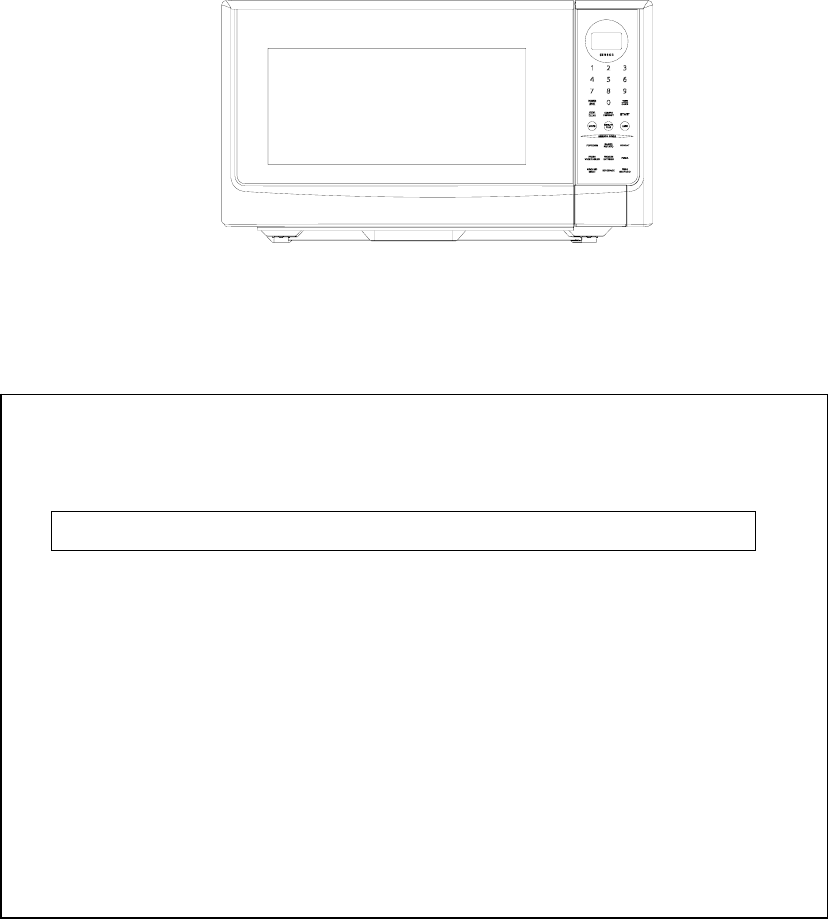
Model: P110N38AP-YZ
Microwave Oven User's manual
1. Please read these instructions carefully before installing and operating the oven. Keep
them for further reference.
2. Record in the space below the SERIAL NO. found on the nameplate on your oven and
retain this information for future reference.
SERIAL NO.:
Please save sales receipt for warranty.
This equipment generates, uses and can radiate radio frequency energy and, if not installed
and used in accordance with the instructions, may cause harmful interference to radio
communications. However, there is no guarantee that interference will not occur in a particular
installation. If this equipment does cause harmful interference to radio or television reception,
which can be determined by turning the equipment off and on, the user is encouraged to try to
correct the interference by one or more of the following measures:
• Reorient or relocate the receiving antenna.
• Increase the separation between the equipment and receiver.
• Connect the equipment into an outlet on a circuit different from that to which the
receiver is connected.
• Consult the dealer or an experienced radio/TV technician for help

1
1. Do not attempt to operate this oven with the door-open since open-door operation can
result in harmful exposure to microwave energy. It is important not to defeat or tamper
with the safety interlocks.
2. Do not place any object between the oven front face and the door or allow soil or
cleaner residue to accumulate on sealing surfaces.
3. Do not operate the oven if it is damaged. It is particularly important that the oven door
close properly and that there is no damage to the:
a) Door (bent),
b) Hinges and latches (broken or loosened),
c) Door seals and sealing surfaces.
4. The oven should not be adjusted or repaired by anyone except properly qualified
service personnel.
CONTENT
PRECAUTIONS TO AVOID POSSIBLE EXPOSURE TO EXCESSIVE MICROWAVE ENERGY 1
IMPORTANT SAFETY INSTRUCTIONS ..............................................................................2
INSTALLATION GUIDE.........................................................................................................4
GROUNDING INSTRUCTIONS............................................................................................4
UTENSILS GUIDE ................................................................................................................5
COOKING TECHNIQUES.....................................................................................................6
SPECIFICATIONS ................................................................................................................7
PART NAMES.......................................................................................................................8
CONTROL PANEL ................................................................................................................9
OPERATION INSTRUCTIONS ...........................................................................................10
Setting the clock..........................................................................................................10
Microwave cooking .....................................................................................................10
Minute plus.................................................................................................................. 11
Setting the timer.......................................................................................................... 11
Touch on .....................................................................................................................11
Sensor cook ................................................................................................................12
Compu defrost ............................................................................................................12
Child lock ....................................................................................................................13
Special feature ............................................................................................................13
CLEANING AND CARE ......................................................................................................14
P
PR
RE
EC
CA
AU
UT
TI
IO
ON
NS
S
T
TO
O
A
AV
VO
OI
ID
D
P
PO
OS
SS
SI
IB
BL
LE
E
E
EX
XP
PO
OS
SU
UR
RE
E
T
TO
O
E
EX
XC
CE
ES
SS
SI
IV
VE
E
M
MI
IC
CR
RO
OW
WA
AV
VE
E
E
EN
NE
ER
RG
GY
Y

2
When using electrical appliances, basic safety precautions should be followed, including the following:
WARNING - To reduce the risk of burns, electric shock, fire, and injury to persons or exposure to
excessive microwave energy:
1. Read all instructions before using the appliance.
2. Read and follow the specific "PRECAUTIONS TO AVOID POSSIBLE EXPOSURE TO
EXCESSIVE MICROWAVE ENERGY" on page 1.
3. This appliance must be grounded. Connect only to properly grounded outlet. See "GROUNDING
INSTRUCTIONS” on page 4.
4. Install or locate this appliance only in accordance with the provided installation instructions.
5. Some products such as whole eggs and sealed containers -for example, closed glass jars- are
able to explode and should not be heated in this oven.
6. Use this appliance only for its intended use as described in this manual. Do not use corrosive
chemicals or vapors in this appliance. This type of oven is specifically designed to heat, cook, or dry
food. It is not designed for industrial or laboratory use.
7. As with any appliance, close supervision is necessary when used by children.
8. To reduce the risk of fire in the oven cavity:
a) Do not overcook food. Carefully attend appliance when paper, plastic, or other combustible
materials are placed inside the oven to facilitate cooking.
b) Remove wire twist-ties from paper or plastic bags before placing bag in oven.
c) If materials inside the oven should ignite, keep oven door closed, turn oven off, and disconnect the
power cord or shut off power at the fuse or circuit breaker panel.
d) Do not use the cavity for storage purposes. Do not leave paper products, cooking utensils or food
in the cavity when not in use.
9. Liquids, such as water, coffee, or tea are able to be overheated beyond the boiling point
without appearing to be boiling. Visible bubbling or boiling when the container is removed from the
microwave oven is not always present. THIS COULD RESULT IN VERY HOT LIQUIDS
SUDDENLY BOILING OVER WHEN THE CONTAINER IS DISTURBED OR A UTENSIL IS
INSERTED INTO THE LIQUID. To reduce the risk of injury to person:
a) Do not overheat the liquid.
b) Stir the liquid both before and halfway through heating it.
c) Do not use straight-sided containers with narrow necks.
d) After heating, allow the container to stand in the microwave oven for a short time before removing
the container.
e) Use extreme care when inserting a spoon or other utensil into the container.
10. Do not heat oil or fat for deep-frying. It is difficult to control the temperature of oil in microwave
oven.
I
IM
MP
PO
OR
RT
TA
AN
NT
T
S
SA
AF
FE
ET
TY
Y
I
IN
NS
ST
TR
RU
UC
CT
TI
IO
ON
NS
S
3
11. Pierce foods with heavy skins such as potatoes, whole squash, apples and chestnuts before
cooking.
12. The contents of feeding bottles and baby jars should be stirred or shaken and the temperature
should be checked before serving in order to avoid burns.
13. Cooking utensils may become hot because of heat transferred from the heated food. Potholders
may be needed to handle the utensil.
14. Do not cover or block any openings on the appliance.
15. Do not store or use this appliance outdoors. Do not use this product near water, for example, near
a kitchen sink, in a wet basement, near a swimming pool, or similar locations.
16. Do not operate this appliance if it has a damaged cord or a plug, if it is not working properly or if it
has been damaged or dropped.
17. Do not immerse cord or plug in water. Keep cord away from heated surface. Do not let cord hang
over edge of table or counter.
18. Use only thermometers, which are specifically designed for use in microwave ovens.
19. Do not operate any heating or cooking appliance beneath this appliance.
20. Be certain the glass tray and roller rings are in place when you operate the oven.
21. This appliance should be serviced only by qualified service personnel. Contact nearest authorized
service facility for examination, repair, or adjustment.
22. When cleaning surfaces of door and oven that comes together on closing the door, use only mild,
nonabrasive soaps, or detergents applied with a sponge or soft cloth.
SAVE THESE INSTRUCTIONS

4
This appliance must be grounded. In the event of an electrical short circuit, grounding reduces risk of
electric shock by providing an escape wire for the electric current.
WARNING Improper use of the grounding plug can result in a risk of electric shock.
Consult a qualified electrician or serviceman if the grounding instructions are not completely understood,
or if doubt exists as to whether the appliance is properly grounded, and either:
1) If it is necessary to use an extension cord, use only a 3-wire extension cord that has a 3-blade
grounding plug and a 3-slot receptacle that will accept the plug on the appliance. The marked rating of
the extension cord shall be equal to or greater than the electrical rating of the appliance, or 2) Do not
use an extension cord. If the power supply cord is too short, have a qualified electrician or serviceman
install an outlet near the appliance.
Electrical Requirements
The electrical requirements are a 120 volt 60 Hz, AC only, 20 amp. It is recommended that a separate
circuit serving only the oven be provided. The oven is equipped with a 3-prong grounding plug. It must
I
IN
NS
ST
TA
AL
LL
LA
AT
TI
IO
ON
N
G
GU
UI
ID
DE
E
G
GR
RO
OU
UN
ND
DI
IN
NG
G
I
IN
NS
ST
TR
RU
UC
CT
TI
IO
ON
NS
S
1. Make sure that all the packing materials
are removed from the inside of the door.
2. Check the oven for any damage, such
as misaligned or bent door, damaged
door seals and sealing surface, broken
or loose door hinges and latches and
dents inside the cavity or on the door. If
there is any damage, do not operate the
oven but contact qualified service
personnel.
3. This microwave oven must be placed
on a flat, stable surface to hold its
weight and the heaviest food likely to be
cooked in the oven.
4. Do not place the oven where heat,
moisture, or high humidity are
generated, or near combustible
materials.
5. For correct operation, the oven must
have sufficient airflow. Allow 20cm of
space above the oven, 10cm at back
and 5cm at both sides. Do not cover or
block any openings on the appliance.
Do not remove feet on which oven
stands.
6. Do not operate the oven without glass
tray, roller support, and shaft in their
proper positions.
7. Make sure that the power supply cord is
undamaged and does not run under the
oven or over any hot or sharp surface.
8. The socket must be readily accessible
so that it can be easily unplugged in an
emergency.

5
be plugged into a wall receptacle that is properly installed and grounded.
Power Supply Cord
1. A short power supply cord is provided to reduce the risks resulting from becoming entangled in or
tripping over a longer cord.
2. Longer cord sets or extension cords are available and may be used if care is exercised in their use.
3. If long cord or extension cord is used:
a) The marked electrical rating of the cord set or extension cord should be at least as great as the
electrical rating of the appliance.
b) The extension cord must be a grounding-type 3-wire cord, and The longer cord should be
arranged so that it will not drape over the counter top or table top where it can be pulled on by
children or tripped over unintentionally.
Notes:
1. If you have any questions about the grounding or electrical instructions, consult a qualified
electrician or service person.
2. Neither Galanz nor the dealer can accept any liability for damage to the oven or personal injury
resulting from failure to observe the electrical connection procedures.
Radio or TV Interference
Should there be any interference caused by the microwave oven to your radio or TV, check that
the microwave oven is on a different circuit, relocated the radio or TV as far away from the oven as
feasible or check position and signal of receiving antenna.
This section lists which utensils can be used in the microwave, which ones have limited use for short
periods, and which ones should not be used in the microwave.
9 RECOMMENDED
Microwave browning dish — Use to brown the exterior of small items such as steaks, chops, or
pancakes. Follow the directions provided with your browning dish.
Microwaveable plastic wrap — Use to retain steam. Leave a small opening for some steam to escape
and avoid placing it directly on the food.
Paper towels and napkins — Use for short-term heating and covering; these absorb excess moisture
and prevent spattering. Do not use recycled paper towels, which may contain metal and could ignite.
Glass and glass-ceramic bowls and dishes — Use for heating or cooking.
Paper plates and cups — Use for short-term heating at low temperatures. Do not use recycled paper,
which may contain metal and could ignite.
Wax paper — Use as a cover to prevent spattering.
Thermometers — Use only those labeled "Microwave Safe" and follow all directions. Check the food in
U
UT
TE
EN
NS
SI
IL
LS
S
G
GU
UI
ID
DE
E

6
several places. Conventional thermometers may be used on microwave food once the food has been
removed from the oven.
Λ
LIMITED USE
Aluminum foil — Use narrow strips of foil to prevent overcooking of exposed areas. Using too much
foil can damage your oven, so be careful. You should keep distance of 1 inch (2.54cm) between
aluminum foil and cavity.
Ceramic, porcelain, and stoneware— Use these if they are labeled "Microwave Safe". If they are not
labeled, test them to make sure they can be used safely.
Plastic — Use only if labeled "Microwave Safe". Other plastics can melt.
8
Not Recommended
Glass jars and bottles — Regular glass is too thin to be used in a microwave. It can shatter and cause
damage and injury.
Paper bags — These are a fire hazard, except for popcorn bags that are designed for microwave use.
Styrofoam plates and cups — These can melt and leave an unhealthy residue on food.
Plastic storage and food containers — Containers such as margarine tubs can melt in the
microwave.
Metal utensils — These can damage your oven. Remove all metal before cooking.
Note:
Should you wish to check if a dish is safe for microwaving, place the empty dish in the oven and
microwave on HIGH for 30 seconds. A dish which becomes very hot should not be used.
Your microwave makes cooking easier than conventional cooking, provided you keep these
considerations in mind:
STIRRING
Stir foods such as casseroles and vegetables while cooking to distribute heat evenly. Food at the
outside of the dish absorbs more energy and heats more quickly, so stir from the outside to the center.
The oven will turn off when you open the door to stir your food.
ARRANGEMENT
Arrange unevenly shaped foods, such as chicken pieces or chops, with the thicker, meatier parts toward
the outside of the turntable where they receive more microwave energy. To prevent overcooking, place
delicate areas, such as asparagus tips, toward the center of the turntable.
C
CO
OO
OK
KI
IN
NG
G
T
TE
EC
CH
HN
NI
IQ
QU
UE
ES
S
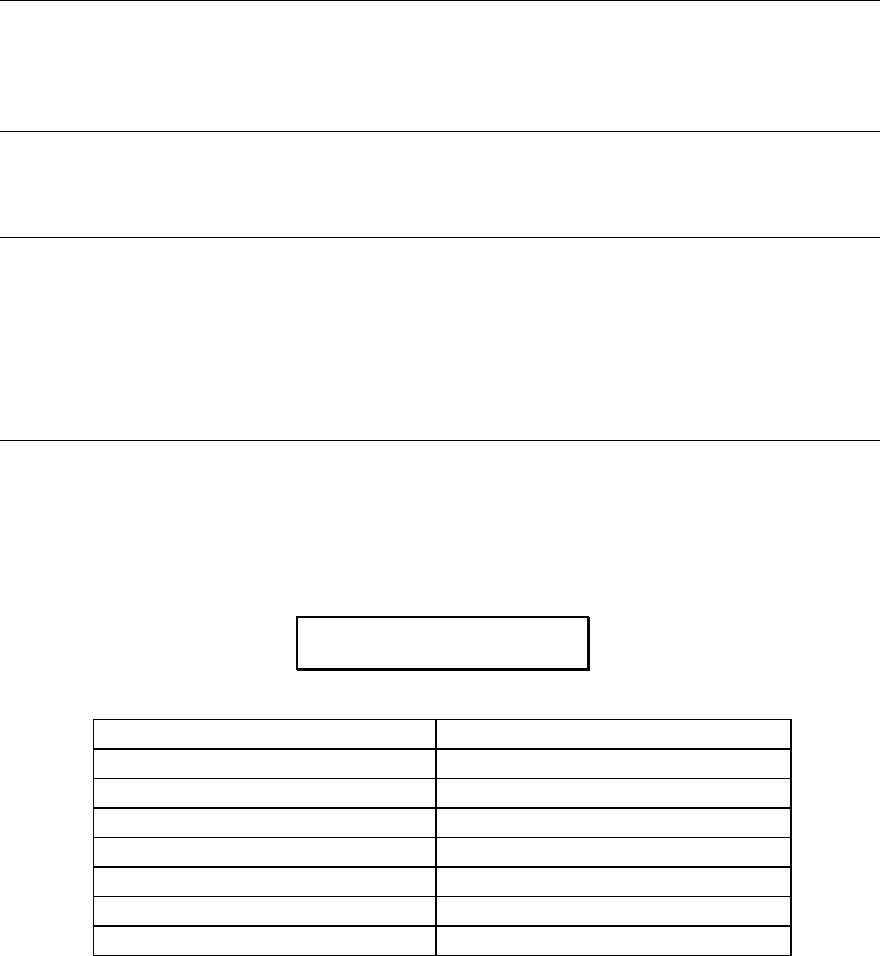
7
SHIELDING
Shield food with narrow strips of aluminum foil to prevent overcooking. Areas that need shielding include
poultry wing tips, the ends of poultry legs, and corners of square baking dishes. Use only small amounts
of aluminum foil. Larger amounts can damage your oven.
TURNING
Turn foods over midway through cooking to expose all parts to microwave energy. This is especially
important with large foods such as roasts.
STANDING
Foods cooked in the microwave build up internal heat and continue to cook for a few minutes after
heating stops. Let foods stand to complete cooking, especially foods such as cakes and whole
vegetables. Roasts need this time to complete cooking in the center without overcooking the outer
areas. All liquids, such as soup or hot chocolate, should be shaken or stirred when cooking is complete.
Let liquids stand a moment before serving. When heating baby food, stir well at removal and test the
temperature before serving.
ADDING MOISTURE
Microwave energy is attracted to water molecules. Food that is uneven in moisture content should be
covered or allowed to stand so that the heat disperses evenly. Add a small amount of water to dry food
to help it cook.
Power Consumption: 120V~60Hz, 1600W (Microwave)
Output: 1100W
Operation Frequency: 2450MHz
Outside Dimensions (H×W×D): 12.3×21.8×17.6 in.
Oven Cavity Dimensions (H×W×D): 9.8×14.8×15.9 in.
Oven Capacity: 1.34 cu.ft
Cooking Uniformity: Turntable System
Net Weight: Approx. 39.7lb.
S
SP
PE
EC
CI
IF
FI
IC
CA
AT
TI
IO
ON
NS
S
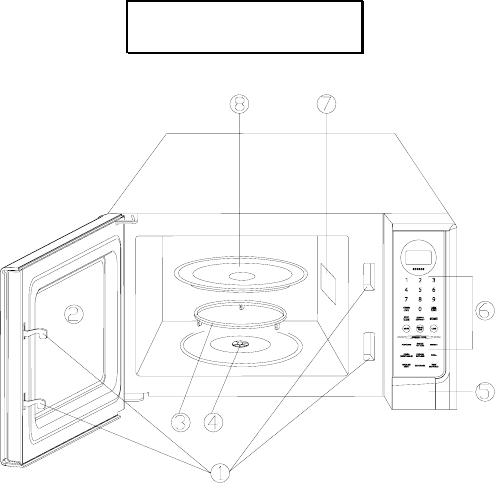
8
1. Door Safety Lock System
2. Oven Window
3. Roller Ring
4. Shaft
5. Door Release Button
6. Control Panel
7. Wave Guide
(Please do not remove the mica plate covering the wave guide)
8. Glass Tray
P
PA
AR
RT
T
N
NA
AM
ME
ES
S
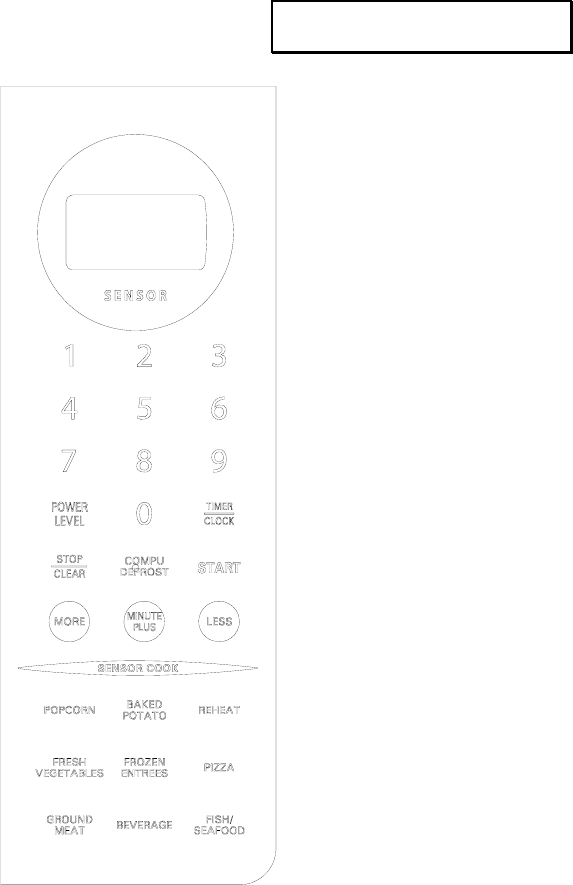
9
Q MENU ACTION SCREEN
Cooking time, power, indicators and present time are
displayed.
Q NUMBER PADS (0-9)
Touch to set clock, cooking time or enter food
weight.
Q POWER LEVEL
Use to set microwave power levels.
Q TIMER/CLOCK
Timer functions independently, even while a cooking
program is in process. You can also touch it to set
the clock.
Q STOP/CLEAR
Touch to stop the oven or reset the oven before
setting a program.
Q COMPU DEFROST
Easy settings to defrost according to weight entered.
Q START
Touch to start the oven.
Q MORE/LESS (+/-)
Used to add or reduce time from cooking.
Q MINUTE PLUS
Touch to add cooking time.
Q QUICK COOK BUTTONS
Instant settings to cook popular foods.
C
CO
ON
NT
TR
RO
OL
L
P
PA
AN
NE
EL
L
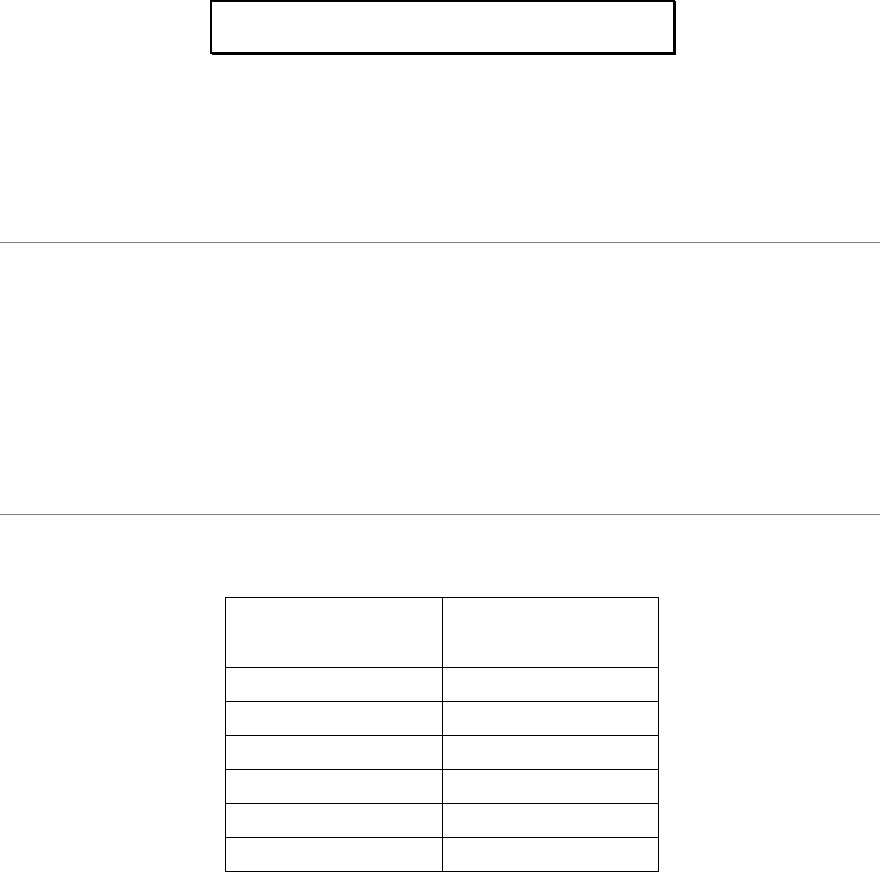
10
SIGNALS DURING OVEN SETTINGS
ONE SIGNAL: Oven accepts the entry.
TWO SIGNALS: Oven does not accept the entry, please check and try again.
SETTING THE CLOCK
1. Touch TIMER/CLOCK pad for 3 seconds to set 12 hour clock; press it again to set the clock in
24-hour cycle.
2. Use the number pads to enter clock time.
3. Touch TIMER/CLOCK pad again.
NOTE: If you enter a wrong time, the oven will beep to remind you after you pressed TIMER/CLOCK
pad. During cooking, you can press TIMER/CLOCK pad to check the clock except sensor cooking
mode.
MICROWAVE COOKING
For pure microwave cooking, there are 6 power levels from which to choose one as the best. The
longest cooking time is 99 minutes and 99 seconds.
You can select the power level by pressing POWER LEVEL:
Press POWER LEVEL
button Cooking Power
Once 100% (P100)
Twice 80% (P-80)
3 times 60% (P-60)
4 times 40% (P-40)
5 times 20% (P-20)
6 times 0% (P-00)
Suppose you want to cook for 5 minutes at 60%:
1. Touch POWER LEVEL to select power level.
2. Use the number pads to enter cooking time.
3. Press START.
NOTE:
O
OP
PE
ER
RA
AT
TI
IO
ON
N
I
IN
NS
ST
TR
RU
UC
CT
TI
IO
ON
NS
S

11
1. If you prefer 100% power level, you can omit the first step.
2. You can check power level during cooking by pressing POWER LEVEL.
3. After total time has elapsed, signals sound and END appears in display. Touch STOP/CLEAR or open
oven door to clear END before starting another cooking function.
MINUTE PLUS
You can set 100% power level cooking quickly by pressing this button to set 1 minute each time. The
longest time you can set is 99 minutes and 59 seconds.
You can also use it to add cooking time of microwave cooking. The longest time you can set is 99
minutes and 99 seconds.
SETTING THE TIMER
1. Touch TIMER/CLOCK pad.
2. Enter the time by touching the number pads.
3. Touch START pad.
NOTE:
1. The maximum time you can enter is 99 minutes and 99 seconds.
2. To cancel the timer, press TIMER/CLOCK, and then press STOP/CLEAR pad within 3 seconds.
3. The timer can be set in standby mode and cooking mode. However, during sensor cook, the timer
function is unavailable.
4. When the countdown ends, the buzzer will beep to remind you.
TOUCH ON
Touch on function is used to set the oven to cook at 100% power level. Press and hold this button to
cook until you think the food is cook as you expect.
STEPS:
1. Place the food into the oven.
2. Press and hold START pad.
3. Release the button when you think the food is cooked well.
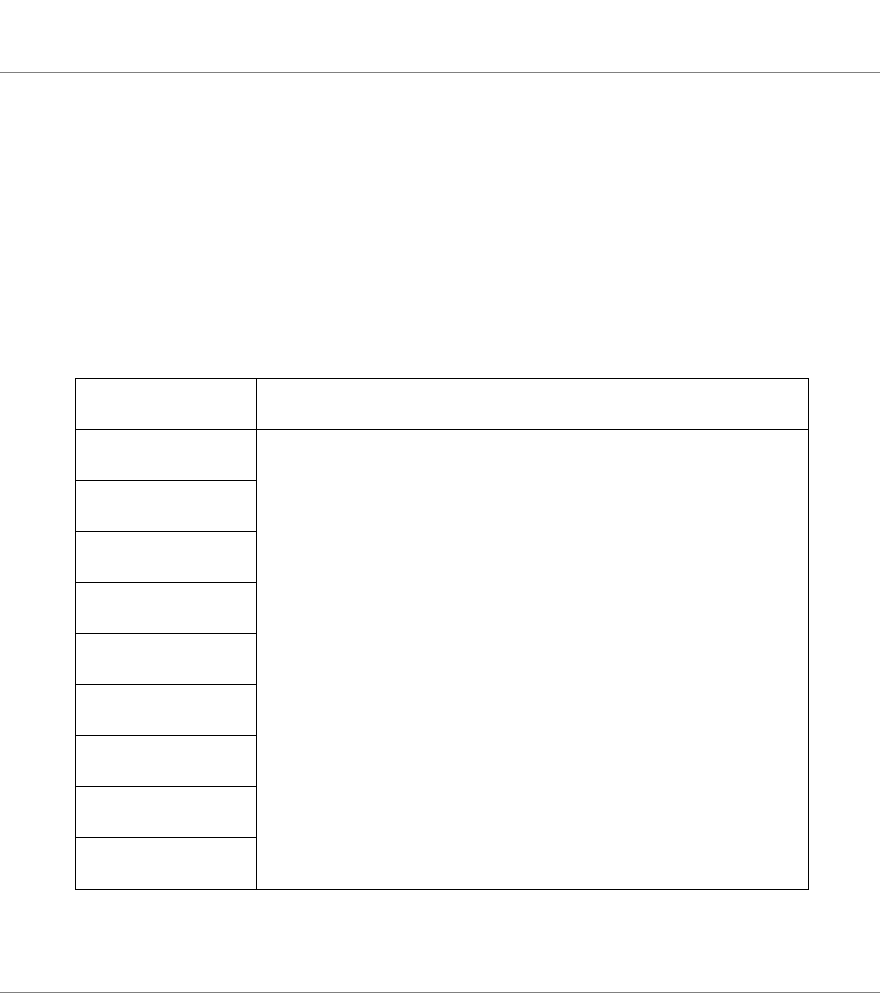
12
SENSOR COOK
The sensor features detect the increasing humidity released during cooking. The oven automatically
adjusts the cooking time to various types and amounts of food.
Suppose you want to cook potatoes:
1. Place the food in the oven and close the door, press BAKED POTATO pad, the oven starts detecting
immediately. (Beeps will sound to signal error operation if door is opened.)
2. Error may occur to the system sensor or else, in this case, the system will stop automatically with the
display showing E0, beeps sound until STOP/CLEAR is pressed.
3. When steam is sensed, corresponding cooking time appears on display and begins counting down.
You can press MORE or LESS to adjust the cooking time. Turn or stir food if necessary.
SENSOR COOKING CHART
Food Pad Note
Potato
Baked Popcorn
Reheat
Fresh Vegetables
Frozen Entrees
Pizza
Ground Meat
Beverage
Fish/Seafood
1. During cooking process, you may touch the MORE or
LESS pad to extend or shorten the cooking time (each touch
for 10 seconds). The longest time you can set is 99:59.
2. If you open the oven door or press STOP/CLEAR during
cooking, the system returns to standby mode immediately.
3. Do not use the sensor features twice in succession on the
same food portion— it may result in severely overcooked or
burnt food. If food is undercooked after the countdown, use
time cooking for additional cooking time.
4. For Beverage, press BEVERAGE and then number pad 1
or 2 to select number of servings.
COMPU DEFROST
The oven could be used to defrost food on the weight you entered. The defrosting time and power level
are automatically set once the weight is programmed. The weight varies between 100g and 1800g.
FOR EXAMPLE: Suppose you want to defrost 600g shrimp.
1. Place the shrimp to be defrosted into the oven.
2. Press COMPU DEFROST button to select food weight.
3. Press START button.

13
Note: During defrosting process, the system will pause to remind user to turn food over, after that, press
START to resume.
CHILD LOCK
Use to prevent unsupervised operation of the oven by little children. The Child Lock indicator will show
on display screen, and the oven can not be operated while the Child Lock is set.
To set: In standby mode, press and hold the STOP/CLEAR button for 3 seconds, a beep sounds and
lock indicator lights.
To cancel: Press and hold the STOP/CLEAR button for 3 seconds until lock indicator light on display
turns off.
SPECIAL FEATURE
AUTO REMINDER
After a cooking or a defrost program, beeps sound and END appears in display. Touch STOP/CLEAR
pad or open oven door to clear END before starting another cooking function.

14
1. Turn off the oven and remove the power plug from the wall socket before cleaning.
2. Keep the inside of the oven clean. When food splatters or spilled liquids adhere to oven walls,
wipe with a damp cloth. Mild detergent may be used if the oven gets very dirty. Avoid the use of
spray and other harsh cleaners as they may stain, streak or dull the door surface.
3. The outside surfaces should be cleaned with a damp cloth. To prevent damage to the operating
parts inside the oven, water should not be allowed to seep into the ventilation openings.
4. Wipe the window on both sides with a damp cloth to remove any spills or spatters.
5. Do not allow the control panel to become wet. Clean with a soft, damp cloth. When cleaning the
control panel, leave oven door open to prevent oven from accidentally turning on.
6. If steam accumulates inside or around the outside of the oven door, wipe with a soft cloth. This
may occur when the microwave oven is operated under high humidity conditions. In such case, it
is normal.
7. It is occasionally necessary to remove the glass tray for cleaning. Wash the tray in warm sudsy
water or in a dishwasher.
8. The roller ring and oven floor should be cleaned regularly to avoid excessive noise. Simply wipe
the bottom surface of the oven with mild detergent. The roller ring may be washed in mild sudsy
water or dishwasher. When removing the roller ring from cavity floor for cleaning, be sure to
replace in the proper position.
9. Remove odors from your oven by combining a cup of water with the juice and skin of one lemon in
a deep microwaveable bowl, microwave for 5 minutes. Wipe thoroughly and dry with a soft cloth.
10. When it becomes necessary to replace the oven light, please consult a dealer to have it replaced.
11. The oven should be cleaned regularly and any food deposits removed. Failure to maintain the
oven in a clean condition could lead to deterioration of the surface that could adversely affect the
life of the appliance and possibly result in a hazardous situation.
12. Please do not dispose this appliance into the domestic rubbish bin, it should be disposed to the
particular disposal center provided by the municipalities.
C
CL
LE
EA
AN
NI
IN
NG
G
A
AN
ND
D
C
CA
AR
RE
E